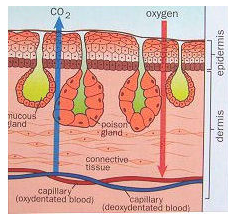From our previous post, we have mentioned that the we see potential of mimicking the frog's skin into a component of an air purifier. One of the reason we find this feasible was because the skin of the frog is not only used for respiration (gaseous exchange), but at the same time, filtering the unwanted particulate matters and hazardous gaseous from the surrounding.
Surprisingly, this idea can be incorporated to one of the group mate's previous project in the Design and Innovation module where an Air Purifier known as de-Hazer was innovated to purify the air in an enclosed area during hazy season by removing the hazardous components in haze without consuming electricity.
Drawings of de-Hazer in Solidworks done by Toh Khai Liang
de-Hazer is designed to fit on top of a ceiling fan,
it can be clamped on the rod of ceiling fan and thus sit on the triangular cap
of the ceiling fan. As most of the current air purifiers in the market operates
with an external source of electricity, de-Hazer is designed to maximize the
usage of a normal ceiling fan by taking advantage of the air circulation
generated by a ceiling fan for an enclosed system. The integration of the
design allows the air cleanser to concentrate the air into the device without
needing a fan on its own and hence minimizing cost of production.
Drawings of de-Hazer in Solidworks done by Toh Khai Liang
When a ceiling fan turns
in a counter clock wise direction, the concentrated room air on the top of the
room is forced to flow down to the bottom surface of the room. The air is then
recirculated back upwards from the side to the top of the room. As the
surrounding air circulates along with the turning blades before being force to
flow downwards, the air cleanser attached on the ceiling fan will capture and
purify the concentrated air.
de-Hazer is designed to a
cylindrical perfection to be clamped onto the rod on top of a ceiling fan. The
air will flow from the top flat surface and exit after purification at the
bottom lower surface of the device. The filters in the device are arranged
perpendicularly to the air flow in order increase the surface area of
filtration and efficiency of the purifier.
There are two main components in this air purifier:
1. The HEPA filter which is used to trap and remove particulate matters from haze
High-efficiency Particulate Air (HEPA) filter
Image source: http://www.ksairfilter.com/mini/
Image source: http://www.ksairfilter.com/mini/
2. Potassium permanganate impregnated with activated alumina to adsorb sulphur dioxide, hydrogen sulphide, and nitrogen sulphides from haze.
Potassium permanganate impregnated with activated alumina
Image source: http://www.environmental-expert.com/products/proguard-300-removes-twice-as-much-toxic-corrosive-and-odorous-gases-from-air-streams-as-our-proguar-289915
Image source: http://www.environmental-expert.com/products/proguard-300-removes-twice-as-much-toxic-corrosive-and-odorous-gases-from-air-streams-as-our-proguar-289915
Based on the components of the air purifier, we foresee a great potential of replacing the HEPA filter with filters made by mimicking the frog's skin. From our previous post regarding the first layer of skin, it is known that epithelium acts as a medium for gaseous exchange and filtration for frog's respiratory system. By studying the anatomy and the structure of the skin cell, discovery can be made on the effectiveness of the skin in filtering particulate matters and gaseous before entering the frog's body.

The epithelium skin of frog
Image source: http://www.pollywogsworldoffrogs.com/
If the filter invented from mimicking the frog skin is tested to be effective, hence this filter will not only be used in de-Hazer, but can be used in many other air purifiers in the market which are using HEPA filters to purify the surrounding air.
Drawing of "Filter" slotted into de-Hazer drawn by Toh Khai Liang










